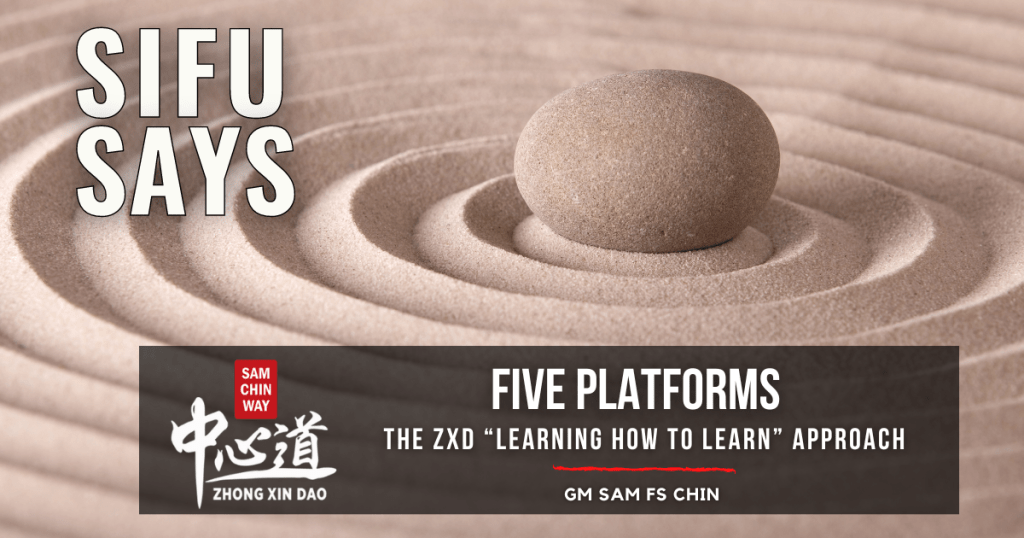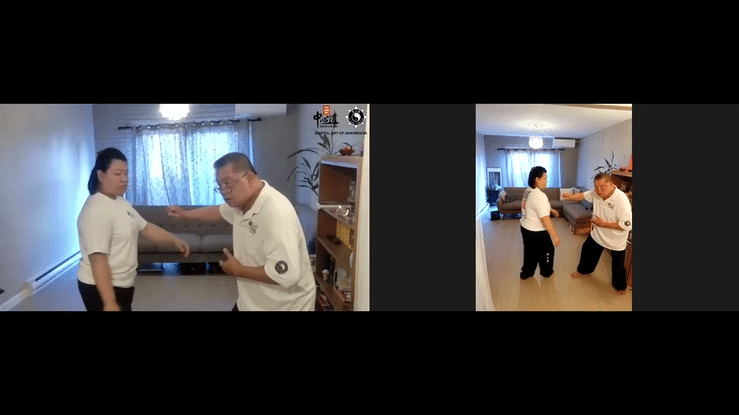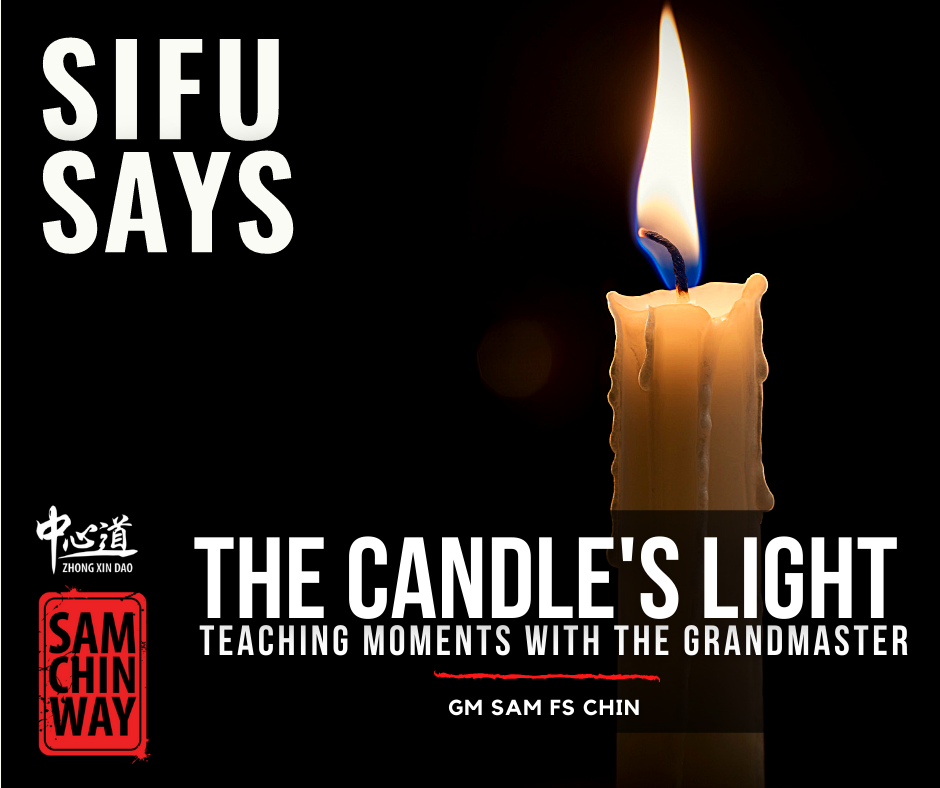

The Five Platforms are about learning how to learn. Understanding the characteristics and functions of nature; of things as they are. Recognizing that there are two types of truth: relative and absolute. How to approach things from the right viewpoint to see down to the base of their origins.
- KNOWLEDGE
- Knowledge from others
- Knowledge from own thinking
- Knowledge from direct experience
- NATURE
- The characteristics of nature are change
(Tao) and impermanence (Zen) - No one-solid entity
- Taoism concept of 1-2-3
- The characteristics of nature are change
- KNOWING
- What is knowing?
- How can we know?
- Knowing is based on what reference?
- ATTENTION
- Recognizing & stabilizing the attention
- Yi 意 / Qi 气 / Li 力
- Concentration, stillness, clarity
- CONTACT
- Point of contact is established with object, subject, consciousness
- Six sense of contact
- Being a receiver
- 3 Knowledges – Learning from others, going to school, listening to others. This is 2nd hand knowledge—it’s very important but you need to know how to listen to it in a way to get the right information—the right concepts and principles. It’s still ‘second hand’ because it’s not yours yet. But it helps us try to understand, contemplate, etc. But it’s still gathered from outside. Yet, you NEED that knowledge to ‘point’—this pointing helps in training to see things through DIRECT experience, direct knowing, first-hand. If you can connect, can you HOLD on the connection enough to SEE? (you might get a little ‘taste’ of present, but then fall back to the past experience to judge it. The challenge is: how to know if you are ‘holding’ on? If our mind runs away, some people don’t yet know it runs awy—that’s why there must be the quality of awareness. Only through ‘direct’ (being in the moment) is their WISDOM! It has a specific quality that you have to recognize. It’s first through recognizing attention and awareness so you can process the awareness. (That’s why I say we must define the concept first—if you haven’t stabilized this awareness yet, you haven’t focused yet). Direct has mental and physical.
- Understand what is the characteristic of Nature Itself. You must know this to maintain direct. First, in Tao, the characteristic is change; in Zen it’s called ‘impermanent.” To understand how thing form, understand 1, 2, 3 (one must have two, two must have three). There’s no 1 “solid” entity: every comes from conditions that come in an form. From this forming of “ONE”, in Tao there is Wu Ji to Tai Ji to yin and yang (it keeps on splitting while remaining complementary). To have complementarity, it must unification AND separation. Look into this platform in order to understand CONSTANT CHANGE. To maintain this clearly, we realize that we must keep on changing WITH the change in order not to change—to be WITH the balancing point. That means we can’t interfere or add and we can’t back-off. The balance point is the present: and we need to SEE from HERE. THIS is direct! The moment of connecting. But how widely can you connect, how widely can you connect and “see”? This is based on both stability and how far. This is where the 3 Engagements come in: Circle with Center, Center-to-Center, and Center with a Cross come in. All these (90/45, connections/reflections, how to feel the return energy, the cycle energy in action—all these are tools to help you see the moment and “know” the moment.
- The KNOWING QUALITY – What is knowing, How can you know, and Knowing based on what reference? Knowing is seeing the difference. (Difference is not comparing, it’s not judging—it’s just a difference). It’s hard to hold onto the difference of seeing the change—we often jump to our past experience to compare [the present has difference, the past has difference—in the past it’s the component of judgement]. Seeing what’s happening in the moment means seeing the cause-and-consequences, the balance. Tao talks about ‘balancing in every action. Zen talks more about “causes and consequences.” From GM Sam’s approach, we must have the balanced actions a balanced cause to have a balanced effect. (a ‘wrong’ move is just a cause that isn’t balanced. Balance the cause and you will balance the effect; so understanding the qwualit itself of balance-ing and relationship of cause and consequence. By direct holding, can you recognize that you’re seeing the moment of change (or are you falling back to a past reference).
- The Awareness-Understanding the Mind itself. Recognizing your attention. Can you see it itself? Can you direct your intentions? If not, how do you know? We need to be able to hold to MEET there—if you’re not ‘present’ there to meet, you won’t be able to see/feel—you won’t be able to MATCH to see the difference to know. Matching is to see the difference. Match to know. [Example of looking at single finger—the lines…sometimes they blur. But keep on balancing your eyes to see the lines, so they don’t blur—keep on constantly adjusting. If you can’t keep adjusting, you can’t keep on ‘holding’, ‘keep on how you stretch,’ on how you hold, stretch and rotate—joint to joint, center to center. Understand that in the same time and same space, the mind can only work on 1 thing at 1 time—without grasping this, you’ll be using the mind incorrectly. The training is to HOLD ONTO 1 NEUTRAL REFERENCE TO SEE ALL. It’s from 1 point of rotation to split off and see all: can you hold onto 1 with attention to see how it connects to all? It requires attention to hold onto rotation to produce forking/splitting attention (it’s a split because it’s a balancing point—the FUNCTION is about the energy going out equally and coming back equally. In order to have equal direction out and in is ONLY THROUGH ROTATION that can spike off in all directions. That’s why the training, in spinning, is about whether YOUR MIND IS WATCHING AND HOLDING (center and circumference—is your MIND recognizing and watching it, that’s conscious training. If you are just ‘doing’ a habit of moving and the mind isn’t there, you aren’t doing it correctly.
[Focusing is balancing also… a kind of clarity…]
- Point of Contact – only 1 can occupy. [First there’s 2 spaces, then we break/penetrate the space: 2 become 1—you merge and occupy the space]. The most important part of Point of Contact is that everything happens there—it’s the 6 senses Point of Contact (listening, seeing, mouth, mind, etc.). “Listening IS learning.” Knowing how to listen –the words that we talk with must be soooo clear—even giving instructions must be clear. Our faculties inform any point of contact: subject, object, consciousness. Our faculties are as a RECEIVER: we see everything INSIDE (smell, taste, hearing, etc.—all is within, internal; if you aren’t clear, you’ll put your attention outside). If you can’t understand this faculty, your training is all wrong. So, you must know how you function. You need to see these to know how to pay attention and how to USE these faculties. Can you See your attention and MONITOR IT? Can you use it to see things clearly as ONE thing!?
Under these 5 platforms we approach under the philosophy of 1 balance point and 1 line.
GM SAM F.S. CHIN zoom talk 9/2/23 on the “ZXD Learning Approach : The Five Platforms”, transcribed by Dr. Nancy Watterson




















You must be logged in to post a comment.